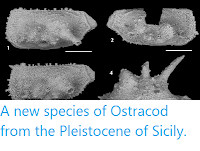Ostracods are small Crustaceans with a bivalved body plan; their
body is sandwiched laterally between two large valves, with the animal using
its legs to generate a current through the shell, enabling it to feed, and in
many cases swim (check). Ostracods are small (seldom much over a millimetre)
and can be very abundant, making them common fossils in many deposits. They
also often have distinctive shell ornamentation, enabling the identification of
species from valves alone, and are both fast-evolving and sensitive to a range
of environmental conditions, making them useful in both biostratigraphy (dating
rocks using fossils) and palaeoenvironmental reconstruction. The Candonidae are a widespread family of predominantly freshwater Ostracods, being particularly numerous in Eurasia. This group is split into three subfamilies, the marine Paracypridinae and the freshwater Candoninae and Cyclocypridinae, with the Cyclocypridinae being distinguished by swimming setae on second antenna and segmented clasping organs, which the Candoninae lack.
In a paper published in the journal Zoological Studies on Okan Külköylüoğlu of the Department of Biology at Abant İzzet Baysal University, Derya Akdemir of İstanbul, Mehmet Yavuzatmaca, also of the Department of Biology at Abant İzzet Baysal University, Benjamin Schwartz of the Edwards Aquifer Research and Data Center and Department of Biology at Texas State University, and Benjamin Hutchins of Texas Parks and Wildlife, describe a new species of Ostracod from Hays County in Texas.
The new species is placed in the Candonin genus Cypria and given the name lacrima, meaning 'tear', in reference to the teardrop shape of the shells of the animals. The species was found in artesain wells accessing the Edwards Aquifer near San Marcos in Hays County. These Ostracods reach slightly over half a millimetre in length, and can be distinguished by the shape and unique ornamentation of the carapace.
Cypria lacrima. (A) Dorsal view, (B) external and (C) internal view of left valve, (D) posterior end of right valve, (E) right valve internal view, (F) internal views of anterior, and (G) posterior ends of left valve. Male (A)-(C), (F), (G); female (E), (D). Scale bars: 100 μm for (A)-(C), (E); 50 μm for (F) 20 μm for (D) 10 μm for (G). Arrows show anterior end. Külköylüoğlu et al. (2017).
See also...
Follow Sciency Thoughts on Facebook.




